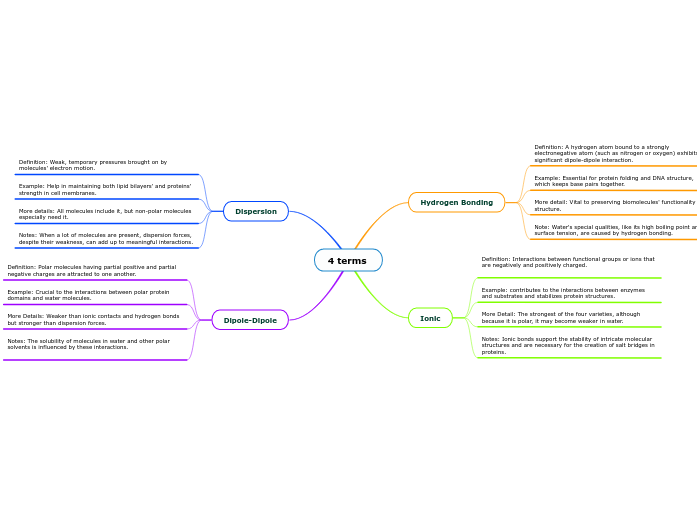4 terms
Hydrogen Bonding
Definition: A hydrogen atom bound to a strongly electronegative atom (such as nitrogen or oxygen) exhibits a significant dipole-dipole interaction.
Example: Essential for protein folding and DNA structure, which keeps base pairs together.
More detail: Vital to preserving biomolecules' functionality and structure.
Note: Water's special qualities, like its high boiling point and surface tension, are caused by hydrogen bonding.
Ionic
Definition: Interactions between functional groups or ions that are negatively and positively charged.
Example: contributes to the interactions between enzymes and substrates and stabilizes protein structures.
More Detail: The strongest of the four varieties, although because it is polar, it may become weaker in water.
Notes: Ionic bonds support the stability of intricate molecular structures and are necessary for the creation of salt bridges in proteins.
Dispersion
Definition: Weak, temporary pressures brought on by molecules' electron motion.
Example: Help in maintaining both lipid bilayers' and proteins' strength in cell membranes.
More details: All molecules include it, but non-polar molecules especially need it.
Notes: When a lot of molecules are present, dispersion forces, despite their weakness, can add up to meaningful interactions.
Dipole-Dipole
Definition: Polar molecules having partial positive and partial negative charges are attracted to one another.
Example: Crucial to the interactions between polar protein domains and water molecules.
More Details: Weaker than ionic contacts and hydrogen bonds but stronger than dispersion forces.
Notes: The solubility of molecules in water and other polar solvents is influenced by these interactions.
